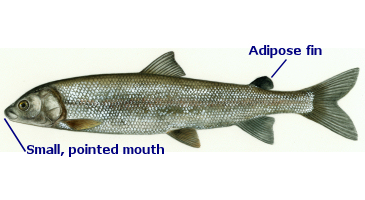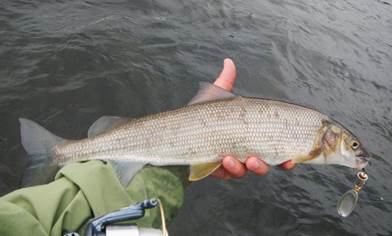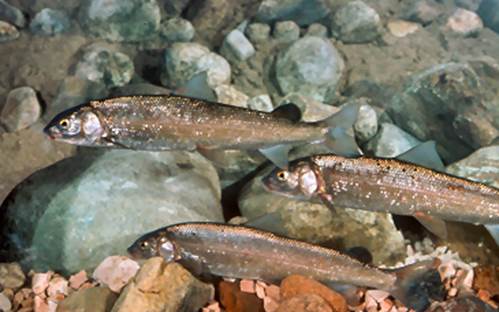……………we saw a number of trout today since the river has become more shallow; also caught a fish of a white colour on the belly and sides and of a bluish cast on the back which had been accedentally wounded by a setting pole. it had a long pointed mouth which opened somewhat like the shad. Meriwether Lewis, July 21, 1805. On the upper Missouri River, near Potts Creek, MT.
This is a widely distributed fish of the salmonid family found from the McKenzie River draining in the far-flung Northwest Territories of Canada south through the upper Missouri drainage to the Truckee River drainage in Nevada and the Sevier River drainage in Utah. While it looks more like a big minnow its adipose fin gives it away as a salmonid (the small fin on its back between the larger dorsal fin and the tail, or caudal fin).


hey are a pretty little fish that is narrow and cylindrical in cross section with a silver tint with olive green on the dorsal side. They have a compact head short snout with a mouth that is beneath the snout. They grow up to 28 inches long and weigh up to 6.4 lbs. The genus Prosopium is from the Greek prosopon, for face; and willimsoni refers to Lieutenant R.S. Williamson of the U.S. Pacific Railroad Exploration. Williamson was assigned to the Corps of Topographical Engineers to conduct surveys for proposed routes for the transcontinental railroad in California and Oregon. His name is attached to Mount Williamson in California (subject of a great photo by Ansel Adams – Adams Photo ), the Williamson’s sapsucker, and Williamson Mountain and the Williamson River in Oregon.
Mountain whitefish – surprise – live in mountain streams and lakes that have clear and cold water with preferences for pools that are deeper than three feet. They are bottom feeders that stir up the substrate with their pectoral and tail fins to expose invertebrates. Their prey includes snails, crayfish, amphipods, among other invertebrates. They seem to prefer feeding in the evening but are opportunistic and will snag items floating by or take advantage of a mayfly hatch, for instance, and feed on the surface.
Spawning occurs between October and December when water temperatures average between 36 -43 deg F. Whitefish will group up to find mates and look for areas of coarse gravel and cobble where they scatter the adhesive eggs that drop into interstitial spaces. The eggs develop slowly in the cold water during winter and take 6 – 10 weeks to hatch in the early spring. The age record is held by a fish caught in Alberta, Canada, which was determined to be over 29 years old.
Fishers don’t often think of the whitefish as a suitable quarry but often catch them while after trout. But it seems attitudes are changing a bit and some folks go after them in catch-and- -release style for the sport.

Years ago (decades really) I was conducting late season snorkel surveys in the mainstem and North Fork Sauk River in WA. It was mid-October and we were in dry suits but by the end of the day your fingers and toes were pretty cold. But we couldn’t resist a float a downstream back to the truck. We drifted over one large scour pool, about 10 feet deep and there, slowly circling halfway down was a school of about 25 mountain whitefish. Freshwater is quite different than saltwater, where in productive areas the amount of fish is pretty dense.
Most of the day we’d seen trout here and there, the odd darter, and the shy bull trout, so this was the largest group of fish we saw all day. It was a quick view as we floated over them with the current, spun around as we glided over the pool turned our heads upstream, and watched them slip out of view as we were pulled out the downstream end of the pool and back into the glides and riffles.
